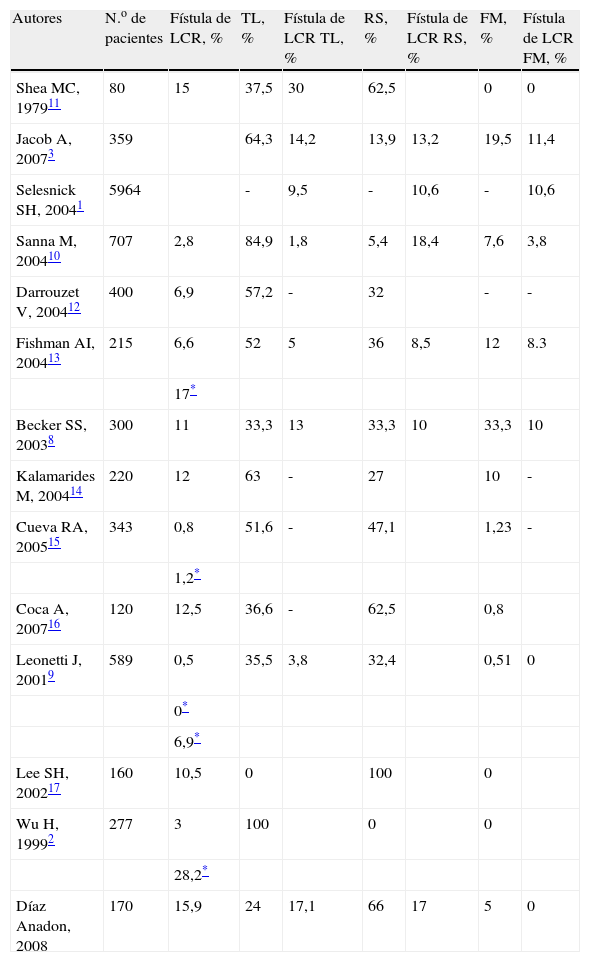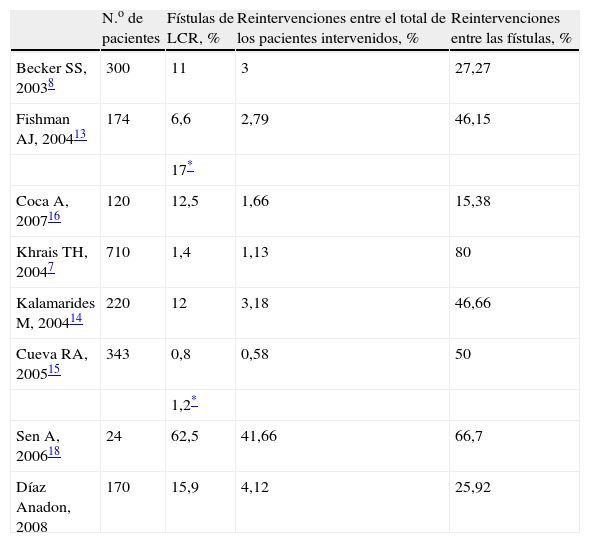La complicación más frecuente tras la cirugía del schwannoma vestibular (SV) es la fístula de líquido cefalorraquídeo.
MétodosEstudio retrospectivo de 170 pacientes intervenidos por SV (163) y otros tumores del ángulo pontocerebeloso (7). La resección se realiza por las vías retrosigmoidea (66%), translaberíntica (24%), fosa media (5%) y otras (5%). Se estudiaron día de aparición, localización, tratamiento e influencia de variables demográficas, clínicas (incluido el índice de masa corporal [IMC]) y radiológicas.
ResultadosSe desarrolló fístula de líquido cefalorraquídeo (LCR) en 27 pacientes (15,9%), de las cuales 15 fueron incisionales (8,8%), 8 fueron rinolicuorreas (4,7%), 1 fue otolicuorrea (0,6%) y 3 fueron una combinación de éstas (1,8%). Se controlaron 11 fístulas con medidas conservadoras (6,5%), 7 pacientes mediante colocación de drenaje lumbar (4,1%), 2 pacientes precisaron drenaje lumbar y cierre con anestesia local (1,2%) y 7 pacientes requirieron reintervención bajo anestesia general (el 4,1% del total). No se demuestra relación significativa entre la aparición de las fístulas de LCR y la vía de abordaje, el tamaño tumoral, la edad ni el IMC.
ConclusionesA pesar de los avances técnicos, la fístula de LCR continúa siendo una complicación frecuente tras la cirugía del SV, no habiéndose desarrollado una técnica que garantice su desaparición. Podría haber otros factores implicados en su etiología, como la presión intracraneal. No se ha demostrado una relación entre las fístulas de LCR y el IMC. El empleo precoz de medidas conservadoras nos ha permitido reducir la tasa de reintervenciones bajo anestesia general a cifras inferiores al 5% de todos los pacientes intervenidos.
The most frequent complication after vestibular schwannoma surgery is cerebrospinal fluid (CSF) fistula.
Material and methodsRetrospective study of 170 patients who had vestibular schwannoma (163) or other tumours in the cerebello pontine angle (CPA) (7). Resection was carried out using different approaches: retrosigmoid (66%), translabyrinthine (24%), middle cranial fossa (5%) and others (5%). We studied the day of onset, location and treatment of the CSF leaks, and the influence of demographic, radiological and clinical variables, including Body Mass Index.
Results27 patients developed a CSF fistula (15.9%): 15 were incisional (8.8%), 8 patients developed CSF rhinorrhea (4.7%), 1 CSF otorrhea (0.6%) and 3 a combination of the above (1.8%). We controlled 11 CSF fistulae with bed rest and compressive dressings (6.5%), 7 required lumbar drainage (4.1%), 2 lumbar drainage and wound closure with local anaesthesia (1.2%) and 7 patients required returning to the operating room under general anaesthesia (4.1%). There was not a significant relationship between the apparition of CSF and tumour size, type of approach, age or body mass index (BMI).
ConclusionsDespite the great development and new surgical techniques, CSF fistulae are still a frequent complication after VS surgery. There might be other aetiological factors such as intracranial pressure. There was no significant relationship between CSF fistula and BMI. Adequate management and early conservative measures led to reduced reintervention rates of less than 5% in all patients.
Artículo
Comprando el artículo el PDF del mismo podrá ser descargado
Precio 19,34 €
Comprar ahora








